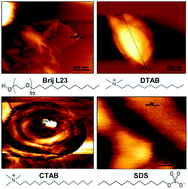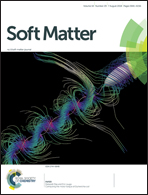Influence of surfactants of different nature and chain length on the morphology, thermal stability and sheet resistance of graphene†
Abstract
The effects of surfactants of different nature (anionic, cationic and non-ionic) and chain length on the morphology, microstructure, thermal stability and electrical resistivity of liquid exfoliated graphene (G) were investigated. Microscopic (SEM and AFM) observations revealed that the thickness of G in the dispersions depended on the surfactant nature: non-ionic surfactants rendered the highest level of exfoliation, whilst dispersions in the cationic ones exhibited fully-covered thicker sheets; the flake thickness increased with increasing surfactant chain length. X-ray diffraction studies indicated an increased interlamellar G spacing with increasing surfactant content. Raman spectra showed an increase in the ID/IG ratio with decreasing G loading. Larger upshifts of the G, 2D and D + G bands were found with increasing surfactant concentration, particularly for dispersions in the cationic surfactants. For the same G/surfactant weight ratio, the electrical resistivity of the dispersions followed the order: cationic > non-ionic > anionic, consistent with the amount of surfactant adsorbed onto G calculated via TGA. It is demonstrated herein that the thermal and electrical properties of liquid exfoliated G can be tuned by varying the surfactant concentration, nature and chain length, which is of great importance for numerous applications like solar power harvesting, high-temperature devices and flexible nanoelectronics.



 Please wait while we load your content...
Please wait while we load your content...